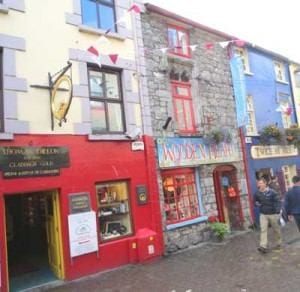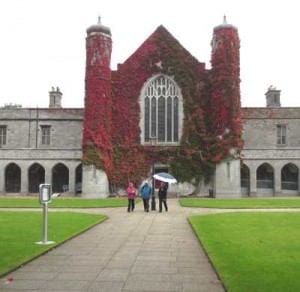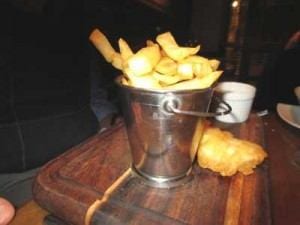Travel Tips
Exploring Ireland’s ‘Wild West’: Galway, Connemara and Inis Mór
 Many a visitor heads home from Ireland after sampling the sights—and the Guinness—in Dublin, Kerry and Cork. Ask the Irish though and they will tell you not to miss West coast: the Celtic culture of Galway city, the romantic moors of Connemara, the fierce cliffs of the Aran isles. In honor of the Gathering and upcoming Saint Patrick’s Day celebration, Lynn Langway reports on the splendors of Ireland’s less-traveled shore.
Many a visitor heads home from Ireland after sampling the sights—and the Guinness—in Dublin, Kerry and Cork. Ask the Irish though and they will tell you not to miss West coast: the Celtic culture of Galway city, the romantic moors of Connemara, the fierce cliffs of the Aran isles. In honor of the Gathering and upcoming Saint Patrick’s Day celebration, Lynn Langway reports on the splendors of Ireland’s less-traveled shore.
If you’ve suffered through too many ragged renditions of “Galway Bay,” you may think you’re immune to the charms of Irish music. But when confronted with the real deal, prepare to be captivated. On a Tuesday night in Galway’s Crane Bar, my husband and I were swept away by the lilting fiddles, booming Bodhran drums and transcendent tin whistle played by the gifted circle of musicians who gathered to jam. The infectious tunes—performed that session by traditional music fans from the National University of Ireland-Galway—were impossible to resist. Soon the whole pub was engaged in an uproar of aerobic approbation, feet stamping and tapping, hands clapping and thumping the tables in time.
 It’s no wonder that Galway boasts about being Ireland’s cultural heart, the most Irish city in the land. It’s as Celtic as a Claddagh ring, the hands-clasping-heart circlet that was supposedly created here in the 17th century, and named for the local fishing enclave. Even a three-day stay will immerse you in Celtic music, theatre, and language; an estimated 10 percent of the city’s population of 75,000 speaks Gaelic, and the National Irish Theatre stages productions here in the ancient tongue. Galway treasures its 800+ years of recorded history. While developers in Dublin were allowed to demolish one ancient site to build a parking garage, city authorities here turned the 13th century town hall that was unearthed during construction into an eye-catching archeological display.
It’s no wonder that Galway boasts about being Ireland’s cultural heart, the most Irish city in the land. It’s as Celtic as a Claddagh ring, the hands-clasping-heart circlet that was supposedly created here in the 17th century, and named for the local fishing enclave. Even a three-day stay will immerse you in Celtic music, theatre, and language; an estimated 10 percent of the city’s population of 75,000 speaks Gaelic, and the National Irish Theatre stages productions here in the ancient tongue. Galway treasures its 800+ years of recorded history. While developers in Dublin were allowed to demolish one ancient site to build a parking garage, city authorities here turned the 13th century town hall that was unearthed during construction into an eye-catching archeological display.
Far from being frozen in amber, fast-growing Galway has turned into one of Europe’s liveliest towns, celebrating anything from art to oysters with citywide festivals. Visit in spring or fall, when 15,000 or so students seem to be everywhere, but the tourists are more scarce, and you’ll discover the old and new sections of the city buzzing with creative restaurants, adventurous museums and galleries, and world-class productions by the acclaimed Druid Theatre Company and several other troupes. Yes, you may well encounter a daily mix of rain showers, clouds and sun—but August tends to be wetter.
 Compact and artfully restored, Galway is a walker’s paradise. The medieval core, walled off by Norman merchants from the “wild Irish” natives about 1270, is less than 20 blocks square, and most major sights are less than a 15-minute walk away. We got our bearings with a witty walking tour, Galway on Foot, led by schoolteacher Sean Leonard, who pointed out details we might not have noticed: the grotesque gargoyle on the façade of one mansion-turned-bank; the “smug angel” in the Church of St. Nicholas that was the only one to escape defacement when Cromwell’s troops sacked the sanctuary in 1652.
Compact and artfully restored, Galway is a walker’s paradise. The medieval core, walled off by Norman merchants from the “wild Irish” natives about 1270, is less than 20 blocks square, and most major sights are less than a 15-minute walk away. We got our bearings with a witty walking tour, Galway on Foot, led by schoolteacher Sean Leonard, who pointed out details we might not have noticed: the grotesque gargoyle on the façade of one mansion-turned-bank; the “smug angel” in the Church of St. Nicholas that was the only one to escape defacement when Cromwell’s troops sacked the sanctuary in 1652.
We stayed at the stylish, comfortable House Hotel right downtown near the iconic Spanish Arch, which made it easy for us wander the stone-paved streets of the old quarter at will, pausing to applaud the better buskers. We started our ramble at the Galway City Museum, a striking architectural combo of soaring space and ancient stone, where exhibits range from historic finds to modern art.
Our favorite shopping stop among many intriguing possibilities was O’ Maille House of Style, where the proprietor knows the life story of every hand-knitter who fashions her chic caps and mohair capes. Across the River Corrib you’ll find the handsome central quadrangle of the National University campus and the imaginative contemporary art showcased in an elegant townhouse at the Galway Arts Center. And if you keep hiking—or give in and grab a taxi–two miles farther west, you’ll hit the white beaches and sweeping promenade of Salthill, where you can join the locals for a jog beside the fabled Galway Bay.
After all that outdoor exercise, we felt free to indulge in plenty of Galway’s inventive cuisine. At Ard Bia, a sophisticated restaurant tucked into a historic waterfront building, we savored tiny local mussels steamed in Irish cider followed by meltingly tender lamb; our dessert, a ginger and blackberry steamed pudding with sea salt ice cream, was so delicious that we had to come back for a second helping with coffee on our last night .
 We happily slurped the small, succulent local oysters– in season from September-May—at the Kirwan’s Lane Seafood Bar, which also serves a greaseless, tempura-like version of fish and chips. Over on the artsy West side of the river, we enjoyed our dinner of flavorful West Coast crab and juicy roast pork at Kai Café, polishing off our poached plums with cardamom custard just in time to stroll down the street to Crane Bar for the nightly 9:30 show. (If you’d prefer your trad music before dinner, the downtown pub Tig Coili puts on a 6:30 pm session).
We happily slurped the small, succulent local oysters– in season from September-May—at the Kirwan’s Lane Seafood Bar, which also serves a greaseless, tempura-like version of fish and chips. Over on the artsy West side of the river, we enjoyed our dinner of flavorful West Coast crab and juicy roast pork at Kai Café, polishing off our poached plums with cardamom custard just in time to stroll down the street to Crane Bar for the nightly 9:30 show. (If you’d prefer your trad music before dinner, the downtown pub Tig Coili puts on a 6:30 pm session).
Galway makes a perfect launch pad for day trips to nearby scenic wonders: take a drive northwest to the mountains of Connemara or a ferry to Inis Mór, the largest Aran island. But we opted for overnight stays in both places, which allowed us to explore. In Connemara, we hiked the hilltops of Connemara National Park and the lakeside trails at the beautiful Ballynahinch Castle Hotel, where breakfast was fabulous and so was the seafood at the Fisherman’s Pub. And on Inis Mór, we stayed at the inviting Kilmurvey House B & B, justly celebrated for its home cooking; you’ll never feel the same about mundane oatmeal after you’ve breakfasted on porridge with cream and a drop of whisky.
The choicest hand-knit Aran scarves and sweaters were sold by the crafts shops just outside the garden gate. And best of all, the inn was located right next to the dramatic ruined fort of Dun Aengus, one of the finest prehistoric sites in Europe, where we could take as much time as we wanted to marvel at the awesome battlements built on cliffs that plunge 300 feet to the sea.
That night, our host drove us to the community center, where the brilliant Druid troupe—which regularly leaves its Galway base to tour throughout Ireland as well as abroad–was staging Tom Murphy’s “Conversations on a Homecoming,” about a disillusioned group of Irish pub regulars in the 1970’s. Outside, a gathering storm raged and howled—as they so often do on these islands. But inside the snug auditorium, we all sat, quiet as could be, enthralled by the hilarious, heartbreaking scenes unfolding before us—spellbound, once again, by the magic of Galway.
Text and photos by Lynn Langway for PeterGreenberg.com. Lynn Langway is an award-winning editor, writer and journalism teacher. Visit her on the Web at www.lynnlangway.com.












